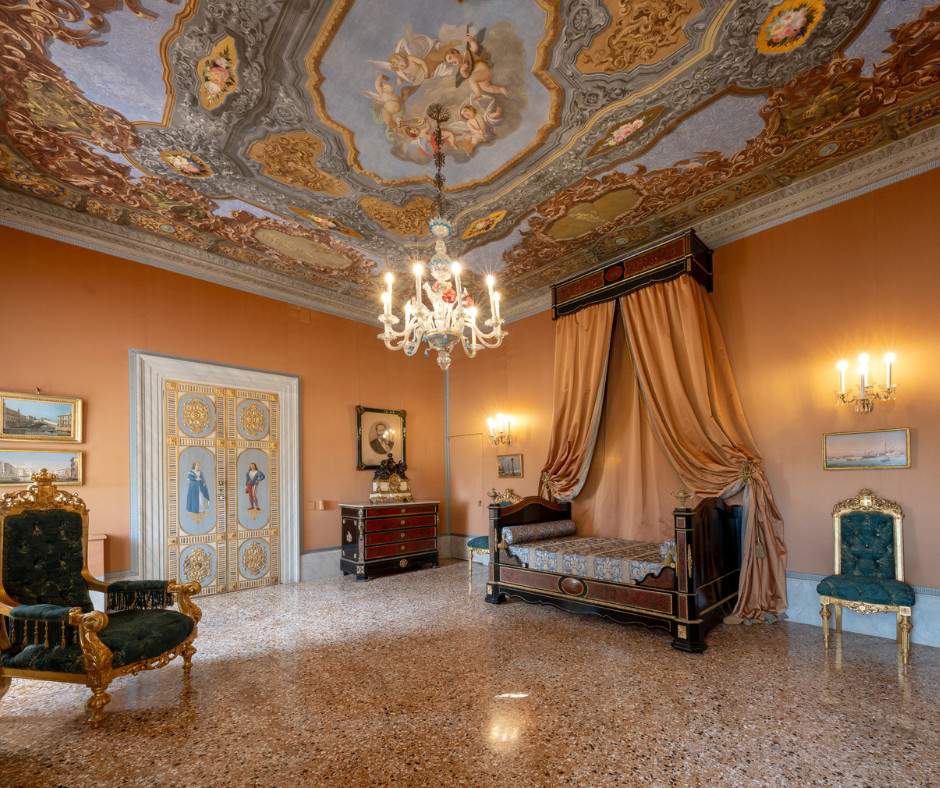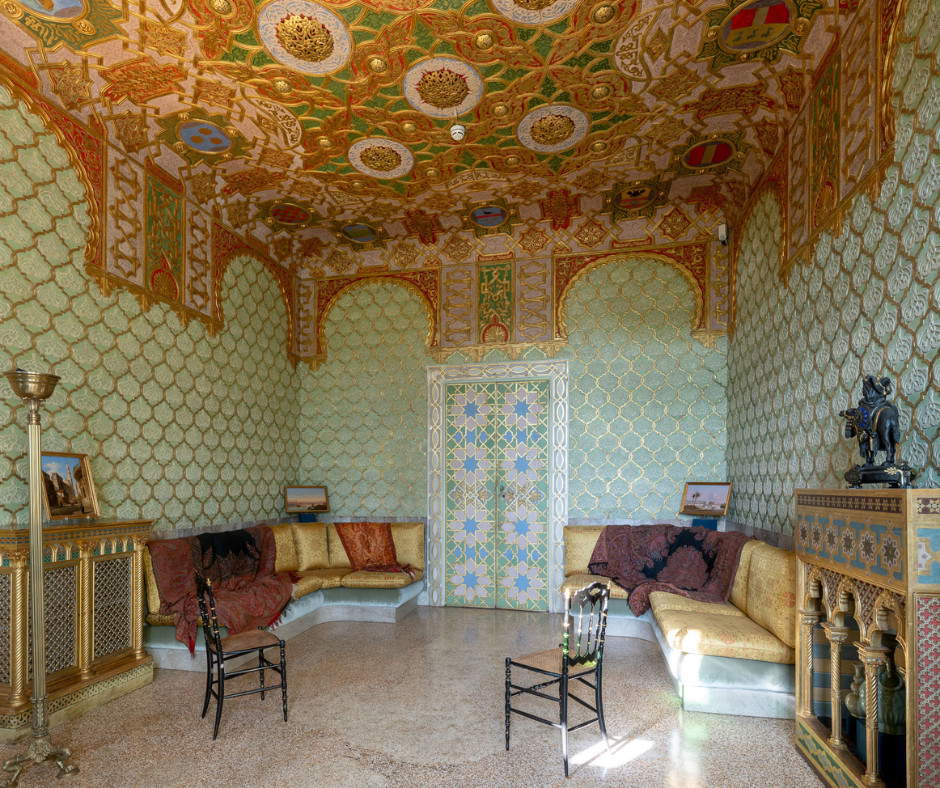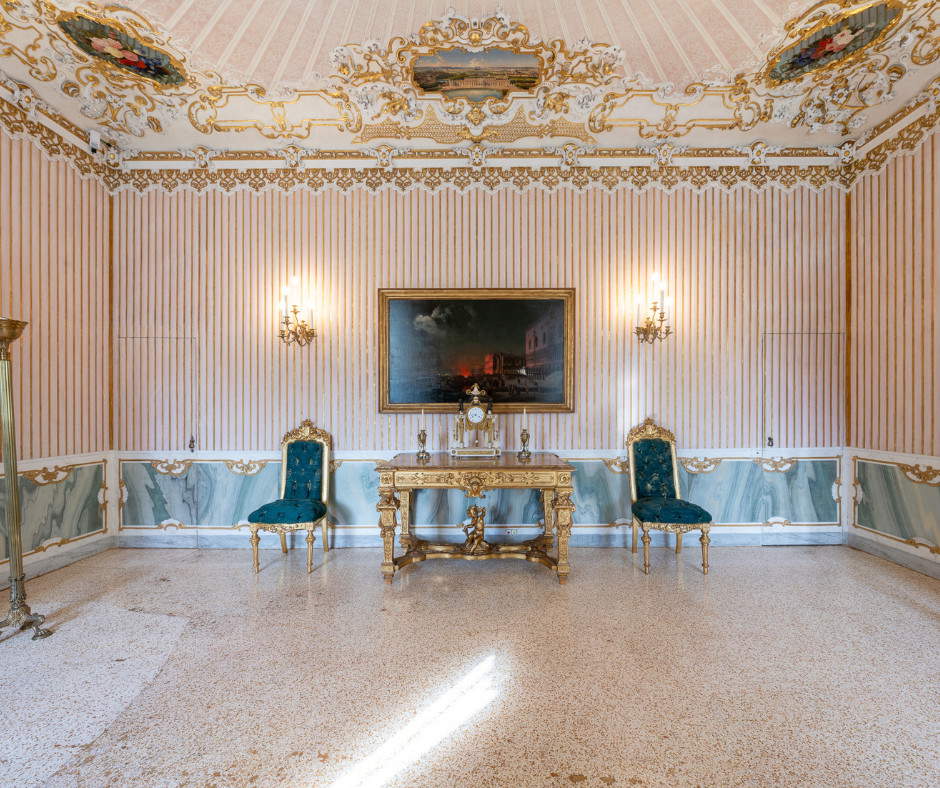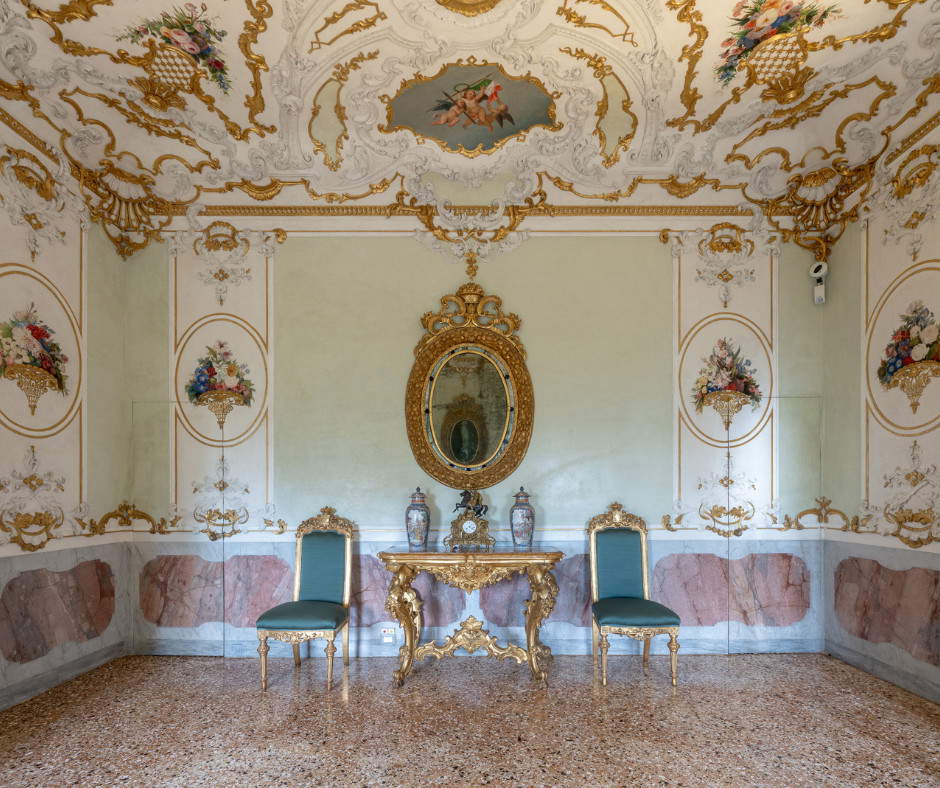The Royal Halls of the Royal Palace of Venice, twenty rooms that today run one after the other in a scenic succession, and which constituted the original private apartments used by the members of three ruling houses, such as the Bonapartes, the Habsburgs and the Savoy, throughout the nineteenth century and until 1920, were once separated into separate apartments accessed by independent entrances and staircases starting from the courtyards, with disobligatory corridors and service rooms at the rear. These rooms therefore underwent numerous modernizations over time, highlighting the evolution of taste and styles. In fact, each of the three Houses that ruled Venice after the fall of the Serenissima Republic wanted to reside in its own apartment, arranged and furnished according to its own taste. However, when the Royal Palace was decommissioned in 1920, most of the twenty Royal Halls facing the Giardini were used as offices of various state administrations, until a restoration project begun in 2000 and brought entirely to completion in 2022 by the Fondazione Musei Civici di Venezia and Comune di Venezia with support from the Soprintendenza and thanks to the generous support of the Comité Français pour la Sauvegarde de Venise and patrons from around the world, has made it possible since last year to open them to the public again.
The Royal Apartments occupy the northern part of the Piano Nobile of the Procuratie Antiche and overlook the Royal Gardens and St. Mark’s Basin. The rooms, which cover about 850 square meters, are all decorated and for the most part sumptuously upholstered with tapestries that echo the original designs; original, on the other hand, are the furniture that came from the Royal Palace and after complex events and various relocations have returned to these rooms. Let’s see what the Correr Museum’s special Sale Reali itinerary looks like today.
We begin with the Weekly Dining Room, decorated by Giuseppe Borsato in 1836, which served as a room for unofficial lunches and an antechamber to the later Lombard-Venetian Throne Room, also decorated by Borsato in 1838 in anticipation of the arrival of Emperor Ferdinand I, and then move on to the Audience Room, adjacent toSissi’s private apartment, where the Empress received accredited persons. This is followed, in fact, by the empress’s bathroom, the study room, the boudoir (a new decoration was made here for Sissi by the ornatist Giovanni Rossi, who, following the tastes of the young empress, enriched the room with lilies of the valley and cornflowers depicted as polychrome flowers among the stucco work), the bedroom (having disappeared the bed of theEmpress, in the Baroque style, today the function of the room is recalled by the presence of an Empire-style sleeping bed by Napoleon’s stepson Eugene Beauharnais; the dormeuse is among the very few pieces of furniture from the Napoleonic era ever remaining in the palace. Then there is the antechamber to the apartments, a private passage between the rooms of Empress Sissi and those of Emperor Franz Joseph, which preserves on its vault the neoclassical geometric decoration of the Napoleonic era by Giuseppe Borsato. Passing through the Oval Hall in neoclassical style with Pompeian-inspired decoration, in which two marble portrait busts of Napoleon Bonaparte and his wife Maria Luisa of Austria made by Luigi Pizzi have been placed, one finds oneself first in the private study of Emperor Franz Joseph, whose ceiling vault presents intact the decoration of the Napoleonic era, and then in his private audience chamber, and after that in the Anticamera dei cambellani. Next we enter the Drawing Room of King Umberto I and the Small Drawing Room of Maximilian of Habsburg, the latter characterized by a ceiling of neo-Renaissance appeal with small coffered frames and rosettes of white stucco with gilding, with pairs of playful polychrome putti painted on the inside.
The Moorish Hall, an Islamic-style room, was commissioned by Archduke Maximilian inspired by two of his trips to Turkey (1850) and Egypt (1855); it was decorated mainly by the Venetian Giovanni Rossi, as was the later Hall of the Cities of Empire, a small, bright and elegant room dedicated to Maximilian and his wife Charlotte of Belgium. The sober walls (an elegant white-and-gold relief stucco stripe) are set against the rich Baroque ceiling with partly gilded stucco curlicues surrounding the central compartment and smaller ones in the center of each side with views of four capitals of the Empire attributable to Frederick Moja (Vienna from the Belvedere; View of Prague; View towards the Duomo in Milan; St. Mark’s Square in Venice).
We almost come to the conclusion of the special tour with the Aurora Drawing Room, in neo-baroque style, then moving on to the King’s Antechamber, which features a sober early 19th-century decoration with simple stucco bands squared off with layers of light marmorino, with yellow-ochre and mauve tones on the backgrounds of the fascias and overdoors, these centered by raised and gilded Medusa heads, and for the chamber of King Victor Emmanuel II, set up on the occasion of his visit on November 7, 1866, to celebrate theunion of Venice and the Veneto region to the Kingdom of Italy; on that occasion the ceiling decoration was redone, painted with cartocci, flowers, and faux riliev in typical late 19th-century tones. Finally, the Living Room of Venice united with Italy, dominated by the allegorical ceiling fresco depicting Venice welcomed by Italy, with putto bearing the result of the plebiscite.
For all information visit the Fondazione dei Musei Civici di Venezia website.
It is possible to make the visit by reservation only and with a qualified guide. It is held for a maximum of 10 people.
Photo by Andrea Avezzù. Courtesy Fondazione Musei Civici di Venezia.





 |
| The Royal Rooms of the Correr Museum: the private apartments where the Bonapartes, the Habsburgs and the Savoy lived |
Warning: the translation into English of the original Italian article was created using automatic tools. We undertake to review all articles, but we do not guarantee the total absence of inaccuracies in the translation due to the program. You can find the original by clicking on the ITA button. If you find any mistake,please contact us.